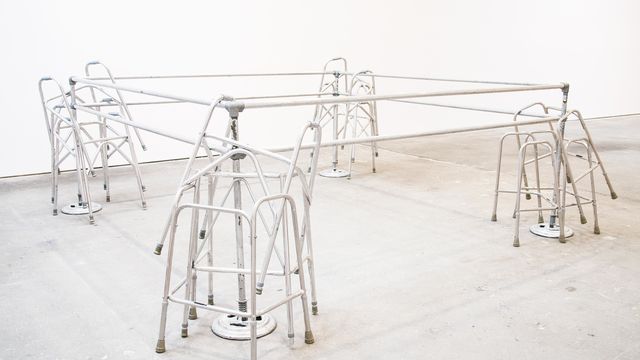
Cady Noland
Working in collage, installation, sculpture, and screen printing, Cady Noland has created incisive works that challenge the American dream, suggesting that the ideal of upward mobility through hard work begets a culture of resentment in the face of celebrity culture and corporate influence on government. Barricades, beer cans, and bullet holes are some of the loaded objects and images that figure prominently in her work. When positioned alongside an American flag or combined with images of famous—or infamous—cultural icons such as Patricia Hearst, Charles Manson, Jacqueline Kennedy Onassis, or Lee Harvey Oswald, the objects in Noland's visual lexicon begin to hum with ideas and questions about the nature and origin of violence, power, and control; the role of fame in late-capitalist society; and the ways in which fear can steer democracy.
The construction of masculinity is one of the many contentious topics that have furnished subject matter for Noland's work. Using symbols of American maleness like beer, cowboys, and tools, she has constructed arrangements of objects that evoke shooting ranges or construction sites, traditionally male realms in which skill is conflated with leisure or labor and the potential for fatal violence is palpably present. Like the shooting range or the construction site, the boxing ring is a masculine-coded site of controlled violence where rules of conduct keep lethality in check. Frame Device (1989) consists of metal pipes and stanchions arranged in a square that resembles a boxing ring. Orthopedic walkers are haphazardly piled in each corner, conspicuously lacking the bodies that they are designed to assist. As in many of Noland's works, the found objects are arranged in such a way as to suggest forgotten elements in a narrative that has changed course or been abruptly halted for a reason as mundane as the dinner bell or as spectacular as a bomb threat. Such conflations move Noland's work beyond piles of detritus into compositions that resonate with social commentary, humor, and deeply held skepticism.
The act of framing is key to Frame Device. The barricades frame and enclose a space, creating a boundary and disallowing movement across its borders. A walker frames the figure using it, and in a metaphorical sense, it also frames the condition that forces the user to take it up, signifying vulnerability or weakness because of illness, injury, or infirmity. Moreover, a "framing device" is a literary trope in which a tangential story occurs within the main story and helps elucidate characters' behavior or a turn in the plot. A story within the overall story of any context within which it is situated, Frame Device's narrative of a staged battle for sport resulting in impaired mobility questions violent behavior as a sanctioned entertainment within an oppressive, controlling society.
—Corrina Peipon


